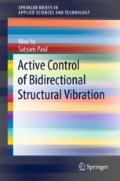Abstract
This chapter provides an overview of modeling of building structures under bidirectional earthquakes. Structural mechanics involves the study of vibrations incorporated in structures. In order to control a structure effectively, it is important to have the knowledge about its dynamics. The control of structures is associated with the safeguard of building structures from unidirectional or bidirectional seismic forces. One of the structural design objects is to model dynamic loadings and to produce innovative approach to curb vibration. The vibration control generates the required dynamics in the building structures within a stable range.
Access this chapter
Tax calculation will be finalised at checkout
Purchases are for personal use only
References
A. Forrai, S. Hashimoto, H. Funato, K. Kamiyama, Structural control technology: system identification and control of flexible structures. Comput. Control Eng. J. 12(6), 257–262 (2001)
J. Zhang, P.N. Roschke, Active control of a tall structure excited by wind. J. Wind Eng. Indus. Aerodyn. 83(1–3), 209–223 (1999)
G.W. Housner, L.A. Bergman, T.K. Caughey, A.G. Chassiakos, R.O. Claus, S.F. Masri, R.E. Skeleton, T.T. Soong, B.F. Spencer Jr., J.T.P. Yao, Structural control: past, present and future. J. Eng. Mech. 123(9), 897–971 (1997)
B. Donaldson, Introduction to Structural Dynamics (Cambridge University Press, UK, 2006)
E. Cruz, S. Cominetti, Three-Dimensional buildings subjected to bidirectional earthquakes. Validity of analysis considering unidirectional earthquakes, in 12th World Conference on Earthquake Engineering (2000)
W.K. Tso, T.J. Zhu, Design of torsionally unbalanced structural systems based on code provisions I: ductility demands. Earthq. Eng. Struct. Dyn. 21(7) (1992)
J.C. Correnza, G.L. Hutchinson, A.M. Chandler, Effect of transverse load-resisting elements on inelastic earthquake response of eccentric-plan buildings. Earthq. Eng. Struct. Dyn. 23(1), 75–89 (1994)
W.H. Wu, J.F. Wang, C.C. Lin, Systematic assessment of irregular building–soil interaction using efficient modal analysis. Earthq. Eng. Struct. Dyn. 30(4), 573–594 (2001)
K.M. Choi, S.W. Cho, D.O. Kim, I.W. Lee, Active control for seismic response reduction using modal-fuzzy approach. Int. J. Solids Struct. 42(16–17), 4779–4794 (2005)
C.C. Lin, C.-C. Chang, J.F. Wang, Active control of irregular buildings considering soil–structure interaction effects. Soil Dyn. Earthq. Eng. 30(3), 98–109 (2010)
J.C. Anderson, F. Naeim, Basic Structural Dynamics (Wiley, Los Angeles, CA, 2012)
A.C. Nerves, R. Krishnan, Active control strategies for tall civil structures, in International Conference on Industrial Electronics, Control, and Instrumentation, vol. 2, Orlando, FL (1995), pp. 962–967
A.K. Chopra, Dynamics of Structures. Prentice-Hall International Series (2011)
F.Y. Cheng, Matrix Analysis of Structural Dynamics: Applications and Earthquake Engineering (CRC Press, New York, 2000)
G.C. Hart, K. Wong, Structural Dynamics for Structural Engineers (Wiley, 1999)
J. Zhang, K. Zeng, J. Jiang, An optimal design of bi-directional TMD for three dimensional structure. Comput. Struct. Eng. 935–941 (2009)
B. Wu, J.P. Ou, T.T. Soong, Optimal placement of energy dissipation devices for three-dimensional structures. Eng. Struct. 19(2), 113–125 (1997)
A. Alavinasab, H. Moharrami, A. Khajepour, Active control of structures using energy-based LQR method, in Computer-Aided Civil and Infrastructure Engineering, vol. 21, no. 8 (2006), pp. 605–611
A.B.M. Saiful Islam, R.R. Hussain, M. Jameel et al., Non-linear time domain analysis of base isolated multi-storey building under site specific bi-directional seismic loading. Autom. Construct. 22, 554–566 (2012)
C.S. Lee, H.P. Hong, Statistics of inelastic responses of hysteretic systems under bidirectional seismic excitations. Eng. Struct. 32(8), 2074–2086 (2010)
F. Ikhouanea, V. Mañosaa, J. Rodellara, Dynamic properties of the hysteretic Bouc-Wen model. Syst. Control Lett. 56(3), 197–205 (2007)
Author information
Authors and Affiliations
Corresponding author
Rights and permissions
Copyright information
© 2020 The Author(s), under exclusive license to Springer Nature Switzerland AG
About this chapter
Cite this chapter
Yu, W., Paul, S. (2020). Structure Models in Bidirection. In: Active Control of Bidirectional Structural Vibration. SpringerBriefs in Applied Sciences and Technology. Springer, Cham. https://doi.org/10.1007/978-3-030-46650-3_2
Download citation
DOI: https://doi.org/10.1007/978-3-030-46650-3_2
Published:
Publisher Name: Springer, Cham
Print ISBN: 978-3-030-46649-7
Online ISBN: 978-3-030-46650-3
eBook Packages: EngineeringEngineering (R0)

